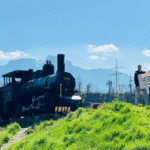Balkan Trip Guide for USA Travelers 2025
Planning a Balkan trip from the United States opens doors to one of Europe’s most fascinating regions. This comprehensive guide covers everything American travelers need for an unforgettable journey through Southeast Europe. From ancient cities to pristine coastlines, the Balkans offer experiences that rival any European destination at a fraction of the cost.
Quick Facts About the Balkans
| Fact | Details |
|---|---|
| Countries | 8 countries: Croatia, Bosnia & Herzegovina, Serbia, Montenegro, Albania, North Macedonia, Kosovo, Slovenia |
| Best Time to Visit | May-June and September-October |
| Average Daily Budget | $50-100 per person |
| Visa Requirements | 90 days visa-free for US citizens |
| Main Airports | Zagreb, Belgrade, Sarajevo, Podgorica, Tirana |
| Languages | Various (English widely spoken in tourist areas) |
| Currencies | Multiple (EUR, RSD, BAM, ALL, MKD) |
The Balkan Peninsula spans eight countries, each offering unique cultural treasures and natural wonders. American visitors find the region surprisingly accessible, with direct flights from major US cities to key hubs like Zagreb, Belgrade, and Athens. English is widely spoken in tourist areas, making navigation easier for US travelers.
Why Choose a Balkan Trip?
- Exceptional Value: Hotel rooms $50-80/night, meals $10-15
- Rich History: Roman ruins to Ottoman architecture
- Natural Beauty: Pristine beaches and mountain ranges
- Easy Access: Direct flights from major US cities
- Safety: One of Europe’s safest regions for tourists
Budget-conscious travelers appreciate the exceptional value. A quality hotel room costs $50-80 per night, while delicious local meals run $10-15. Public transportation efficiently connects major destinations, and rental cars offer freedom to explore hidden gems. Most countries use different currencies, but euros work in several destinations.
Planning Your Perfect Balkan Trip from the USA
Creating an ideal Balkan trip requires strategic planning to maximize your time and budget. Start by choosing your travel style: organized tours offer convenience, while independent travel provides flexibility. Both approaches work well in this tourist-friendly region.
Flight Connections from USA
Major Routes:
- New York → Zagreb (1 stop)
- Chicago → Belgrade (1 stop)
- Los Angeles → Athens → Balkans
- Miami → Vienna → Balkans
Essential Pre-Trip Checklist
Currency Planning Guide
| Country | Currency | Symbol | Approx. USD Rate |
|---|---|---|---|
| Croatia | Euro | EUR | 1 USD = 0.93 EUR |
| Serbia | Serbian Dinar | RSD | 1 USD = 108 RSD |
| Bosnia | Convertible Mark | BAM | 1 USD = 1.82 BAM |
| Montenegro | Euro | EUR | 1 USD = 0.93 EUR |
| Albania | Albanian Lek | ALL | 1 USD = 101 ALL |
| N. Macedonia | Macedonian Denar | MKD | 1 USD = 57 MKD |
| Kosovo | Euro | EUR | 1 USD = 0.93 EUR |
| Slovenia | Euro | EUR | 1 USD = 0.93 EUR |
Best Balkan Tour Packages for American Travelers
Organized Balkan tour packages simplify logistics while ensuring you see top attractions. Reputable companies design itineraries specifically for North American travelers, including English-speaking guides and comfortable pacing.
Tour Types Comparison
| Tour Type | Daily Cost | Group Size | Best For |
|---|---|---|---|
| Budget Backpacker | $80-120 | 12-16 people | Young travelers, hostels |
| Small Group | $150-200 | 8-12 people | Balance of social & flexibility |
| Luxury | $300-500 | 6-10 people | Premium experiences |
| Adventure | $175-250 | 8-12 people | Active travelers |
| River Cruise | $200-400 | 100+ people | Relaxed pace, no packing |
| Private Custom | $250-600 | Your group only | Ultimate flexibility |
Recommended Tour Operators
Budget-Friendly Options:
- Intrepid Travel: Small groups, local experiences
- G Adventures: Young traveler focus
- Busabout: Hop-on, hop-off flexibility
Mid-Range Excellence:
- Rick Steves: Educational focus
- Trafalgar: Well-organized itineraries
- Cosmos: Value-oriented tours
Luxury Providers:
- Abercrombie & Kent: Ultra-premium experiences
- Tauck: All-inclusive luxury
- Viking River Cruises: Danube journeys
Essential Balkan Itinerary Options
7-Day Highlights Tour
Perfect for first-time visitors with limited time.
Day 1-2: Dubrovnik, Croatia
- Explore medieval walls
- Cable car to Mount Srd
- Island day trip
Day 3: Kotor, Montenegro
- Bay cruise
- Climb fortress walls
- Visit Perast
Day 4-5: Sarajevo, Bosnia
- War tunnel museum
- Baščaršija old bazaar
- Traditional dinner
Day 6-7: Belgrade, Serbia
- Kalemegdan Fortress
- Bohemian quarter
- River nightlife
14-Day Classic Circuit
| Days | Location | Highlights |
|---|---|---|
| 1-2 | Zagreb, Croatia | Upper town, museums, cafes |
| 3 | Plitvice Lakes | Waterfalls, hiking trails |
| 4-5 | Split, Croatia | Diocletian’s Palace, islands |
| 6-7 | Dubrovnik | Old town, city walls |
| 8-9 | Kotor, Montenegro | Bay views, medieval town |
| 10-11 | Sarajevo, Bosnia | History, culture, cuisine |
| 12-13 | Belgrade, Serbia | Fortress, nightlife, museums |
| 14 | Departure | Airport transfer |
Budget-Friendly Balkan Vacation Tips
Daily Budget Breakdown
| Expense Category | Backpacker | Mid-Range | Luxury |
|---|---|---|---|
| Accommodation | $15-25 | $50-80 | $150+ |
| Meals | $15-20 | $30-40 | $60+ |
| Transportation | $10-15 | $20-30 | $50+ |
| Activities | $10-15 | $25-35 | $50+ |
| Total Daily | $50-75 | $125-185 | $310+ |
Money-Saving Strategies
Must-Visit Countries on Your Balkans Trip
Croatia 🇭🇷
Why Visit: Stunning coastline, medieval cities, island paradise
Top Attractions:
- Dubrovnik Old Town
- Plitvice Lakes National Park
- Hvar Island beaches
- Split’s Diocletian’s Palace
- Zagreb’s cafe culture
Best Time: May-June, September-October
Budget: $70-100/day
Bosnia and Herzegovina 🇧🇦
Why Visit: Moving history, Ottoman heritage, natural beauty
Must-See Places:
- Sarajevo’s resilient spirit
- Mostar’s iconic bridge
- Kravice Waterfalls
- Una National Park
- Trebinje wine region
Best Time: April-October
Budget: $40-60/day
Serbia 🇷🇸
Why Visit: Vibrant nightlife, warm hospitality, rich culture
Highlights:
- Belgrade fortress and nightlife
- Novi Sad and EXIT Festival
- Đerdap National Park
- Devil’s Town rock formations
- Monastery wine routes
Best Time: May-September
Budget: $45-70/day
Montenegro 🇲🇪
Why Visit: Dramatic coastline, mountain adventures
Top Spots:
- Bay of Kotor
- Durmitor National Park
- Budva beaches
- Sveti Stefan island
- Tara River Canyon
Best Time: June-September
Budget: $60-80/day
Albania 🇦🇱
Why Visit: Undiscovered beaches, authentic experiences, lowest prices
Hidden Gems:
- Albanian Riviera beaches
- Theth mountain village
- Butrint ancient ruins
- Tirana’s colorful buildings
- Lake Ohrid shores
Best Time: May-October
Budget: $35-50/day
Balkan Road Trip Routes and Transportation
Classic Coastal Route (10-14 days)
Distance: ~1,200 miles
Driving Time: 30-35 hours total
Highlights: Island hopping, beach stops, coastal towns
Cultural Capitals Circuit (14-18 days)
Distance: ~1,500 miles
Driving Time: 35-40 hours total
Focus: Cities, museums, nightlife, local culture
Car Rental Essentials
| Aspect | Details |
|---|---|
| Daily Cost | $25-40 + insurance |
| Fuel Cost | $5-6 per gallon |
| Documentation | International permit required |
| Cross-border | Check restrictions (especially Kosovo) |
| Insurance | Full coverage recommended |
| GPS | Essential, download offline maps |
Southeast Europe Trip Planning Essentials
Packing Checklist
Clothing:
Electronics:
Communication Tips
| English | Croatian | Serbian | Albanian |
|---|---|---|---|
| Hello | Bok | Zdravo | Përshëndetje |
| Thank you | Hvala | Hvala | Faleminderit |
| Please | Molim | Molim | Ju lutem |
| Yes/No | Da/Ne | Da/Ne | Po/Jo |
| Cheers! | Živjeli | Živeli | Gëzuar |
Balkan Peninsula Travel Safety and Requirements
Entry Requirements by Country
| Country | Visa-Free Days | Special Notes |
|---|---|---|
| Croatia | 90 days | Schengen rules apply |
| Bosnia | 90 days | Register within 48 hours |
| Serbia | 90 days | Kosovo stamp issues |
| Montenegro | 90 days | Tourist tax applies |
| Albania | 90 days | Year-round entry allowed |
| N. Macedonia | 90 days | No restrictions |
| Kosovo | 90 days | Not recognized by all |
| Slovenia | 90 days | Schengen member |
Emergency Contacts
| Service | Number |
|---|---|
| European Emergency | 112 |
| US Embassy Belgrade | +381 11 706 4000 |
| US Embassy Zagreb | +385 1 661 2200 |
| US Embassy Sarajevo | +387 33 704 000 |
| US Embassy Podgorica | +382 20 410 500 |
| US Embassy Tirana | +355 4 2247 285 |
Best Time for Your Balkan Holiday
Seasonal Overview
| Season | Weather | Crowds | Prices | Best For |
|---|---|---|---|---|
| Spring (Apr-May) | Mild, some rain | Low | Budget | Nature, cities |
| Summer (Jun-Aug) | Hot, sunny | High | Peak | Beaches, festivals |
| Fall (Sep-Oct) | Warm, dry | Medium | Moderate | Everything |
| Winter (Nov-Mar) | Cold, wet coast | Minimal | Lowest | Cities, skiing |
Special Events Calendar
| Month | Event | Location |
|---|---|---|
| January | Orthodox Christmas | Serbia, Montenegro |
| February | Sarajevo Winter Festival | Bosnia |
| April | Orthodox Easter | Throughout |
| June | INmusic Festival | Zagreb |
| July | EXIT Festival | Novi Sad |
| July | Dubrovnik Summer Festival | Croatia |
| August | Guca Trumpet Festival | Serbia |
| September | Wine Harvest | Macedonia, Serbia |
| October | Sarajevo Film Festival | Bosnia |
| December | Christmas Markets | Zagreb, Belgrade |
Booking Your Balkan Tour from USA
Booking Timeline
6 Months Before:
- Research destinations
- Compare tour operators
- Check passport validity
4 Months Before:
- Book flights
- Reserve tours
- Start visa process (if needed)
2 Months Before:
- Book accommodation
- Purchase insurance
- Plan daily itineraries
1 Month Before:
- Confirm all bookings
- Download apps
- Notify banks
1 Week Before:
- Check-in online
- Print documents
- Pack bags
Final Pre-Departure Checklist
Documents:
Financial:
Technology:
Ready to Start Your Balkan Adventure?
This guide provides everything needed for American travelers to explore one of Europe’s most rewarding regions. From medieval cities to pristine beaches, the Balkans await your discovery!
Start Planning Your Trip

